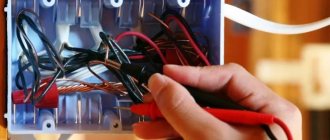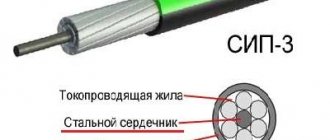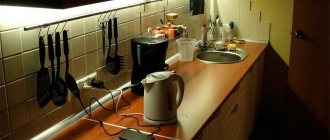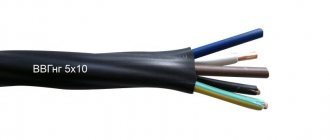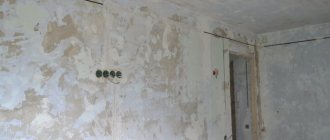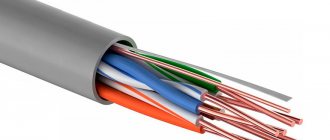Recently, visitors to our site contacted us with a request to dwell in more detail on such an issue as the cross-section of wires in a city apartment. This is the reason for the appearance of this article, which, I hope, will be useful for those who are planning to make repairs or are simply concerned about the state of the electrical wiring in their home.
Even an uninitiated person understands that the size of the cross-section is determined by the total power of the devices connected to the intra-apartment electrical network. Its different sections are subject to different loads, according to which the thickness of the cable should be selected, which can be:
- Introductory.
- Powering an electric stove or hob.
- Serving socket groups.
- Powering lighting fixtures.
It is from the above division that I will proceed when talking about what cross-section a cable laid in a certain part of the apartment wiring should have.
If you are planning to install electrical wiring in your apartment with your own hands, be sure to read this article! It will help you avoid a large number of possible mistakes.
Residential input cable cross-section
The power per input cable and, accordingly, the strength of the current carried by it is limited by the amount of allocated power, determined by Energosbyt and controlled by the input machine. Its response threshold is usually 25A. Most often, in apartment buildings, incoming automatic machines are installed in electrical panels outside apartments. The cable laid from the machine inside the living quarters is precisely the introductory one, which I will now talk about.
In apartments, the cross-section of the input cable can be:
- in single-phase networks - copper cable 3x10 mm2 (three-core - phase, ground and neutral; 10 mm2 for each core) paired with a 50 A circuit breaker;
- in three-phase networks - copper cable 5x4 mm2 (five-core - three phases, ground and neutral; 2.5 mm2 for each core) paired with a 25 A circuit breaker.
The power supplied may vary depending on the age of the building and whether it has gas or electric stoves. Indirect evidence of the real value of this parameter can be the nominal value of the machine at the entrance to the apartment. In any case, you will never regret if the wires indicated just above are used as the input cable.
Existing types of products
It is difficult to unambiguously answer the question of what wires and cables are needed for wiring in the residential premises of an apartment, since such work requires various types of similar products.
According to current safety regulations, all household appliances and sockets must be grounded. Therefore, in apartments, a three-core cable is installed everywhere, having a “phase”, “zero” and “ground”
For the lighting circuit, which receives the least load from the electrical network, a cable with a cross section of 1.5 mm2 is suitable. For it, it is enough to provide a 10 A (2.3 kW) circuit breaker.
For sockets, the load in which can reach up to 3-4 kW, it is necessary to take products with a cross-section of 2.5 square meters. mm, capable of withstanding current up to 27 A and power 5.9 kW.
However, you should not load the line to such limits: for correct operation, a reserve of one third of the planned load is required. In this case, you will need a switch rated at 16 A (3.6 kW).
If you plan to install an outlet for an electric stove (hob), you need to lay a cable with a cross-section of 6 square meters. mm for power up to 10.1 kW.
In this case, it is important to select an appropriate machine designed for an electric current of 32 A (voltage 7.3 kW). When choosing the parameters of the input cable to the apartment, it is important to take into account the power allocated to the apartment
As a rule, in this case it is necessary to use a product with a cross section of 6-10 square meters. mm
When choosing the parameters of the input cable to the apartment, it is important to take into account the power allocated to the apartment. As a rule, in this case it is necessary to use a product with a cross section of 6-10 sq.
mm.
Cable for apartment sockets
The optimal cross-section of wires serving apartment socket groups is 2.5 mm2. This allows them to withstand currents of up to 27 A, which corresponds to a total power of approximately 6 kW. The use of conductors with a larger cross-section, for example, 4 mm2, is impractical because:
- Such cables simply cannot fit into the terminals of socket mechanisms.
- Laying such cables is significantly more expensive and is not economically feasible.
And there is no practical need for thicker cables, because... It is rare to find household electrical appliances plugged into an outlet whose power exceeds 3.5 kW. Thus, by placing cables with a cross-section of 2.5 mm2 in the wiring of the socket groups, you can sleep peacefully: they are able to withstand any electrical appliances, even if they operate for a long time.
Example of calculating section diameter
The structure of the material from which the wires are made is the main criterion for choosing the diameter. The correct choice of the diameter of the wires used ensures a uniform supply of current to certain devices. In addition, the required cross-section guarantees the reliability and safety of the electrical system.
The main indicators for calculating the cross section are the following:
- metal that is part of the current-carrying conductors (aluminum or copper);
- selection of operating voltage of group B;
- power consumption, kilowatt, and electrical load of group A.
Using a wire with a cross-section smaller than the recommended one leads to unpleasant consequences - heating, insulation failure and fire. Also, using a larger cross-section can lead to an increase in electrical performance, which will have an unpleasant impact on your wallet. Therefore, determining the correct cross-section diameter must be approached with special care.
There are a few key points to understand:
- Copper wires with a cross-section of one and a half square millimeters provide a current load of 4 kW, that is, 19 amperes;
- Copper wires with a cross section of 2.5 square meters. mm guarantee a consumption of 6 kW, or more specifically - 27 amperes;
- Electrical wiring made of copper with a cross-section of 6 millimeters square provides an electric current power of 10 kW.
If you comply with the above consumption standards, your network will operate normally.
In apartments of any size, electrical power is divided into 2 types:
- power;
- lighting
Most often, a powerful electrical cable is installed in the kitchen area, because this is where the equipment that consumes the most electricity is concentrated (microwave oven, hob, electric stove, toasters, electric kettles, etc.). Such a powerful group requires a cable with a cross-sectional diameter of 2.5 square meters. millimeter. In the kitchen it is allowed to install sockets in the quantity necessary for convenient use of equipment.
For other rooms, wires with a cross-section of one and a half square millimeters are used. The largest cross-section of wires is 6 square meters. mm - necessary for the input cable, since the main current load into the apartment passes through it.
To calculate a power of 5 kilowatts, the following points should be adhered to:
- There is no load of 5 kW in the table, so first you need to select an indicator as close as possible to this power, it will be 5.5 kW;
- Choice of voltage 220 or 320 volts;
- Choosing a method for laying electrical wires;
- Specify the material used - copper or aluminum.
To supply an electrical network of this power, copper wires should be used. This load is considered often used in houses and apartments.
Lighting system wire cross-section
Surely, you yourself understand that lighting fixtures place the least amount of stress on apartment electrical wiring. Therefore, a wire cross-section of 1.5 mm2 is quite sufficient for a standard apartment in an apartment building. However, when laying the wiring, you should be absolutely sure that the total load of each lighting group does not exceed 3.5 kW. Due to the traditionally low load, all apartment lighting, as a rule, is reduced to one group, served by a 1.5 mm2 cable.
A wire cross-section of 1.5 mm2 is quite sufficient for wiring that supplies power to lighting fixtures
So, to summarize, I’ll just remind you of the bare numbers. Most often, the cross-section of wires in a city apartment is:
- input cable – 3×10 mm2 (single-phase network), 5×2.5 mm2 (three-phase network);
- electric stove (hob) – 3×6 mm2 (single-phase network), 5×2.5 mm2 (three-phase network);
- rosette groups – 3×2.5 mm2;
- lighting devices – 3×1.5 mm2.
However, I must emphasize the phrase “most often” that I used. If you initially plan to install very powerful devices in your apartment, then before laying the electrical wiring you should make the necessary calculations so as not to make a mistake in choosing cables of the required cross-section. The best option is to contact a professional electrician.
A simple way to select a section
Replacing electrical wiring in an apartment or private house with your own hands begins with determining the parameters of the wire that will be used. Typically, the wiring diagram in a house consists of a lighting circuit, a circuit of sockets and an underwater (input) cable. What should be the cross-section of all these wires and the input cable? If your apartment or house contains the most common standard household appliances, then a simplified method for selecting the wire cross-section for the home electrical network offers the following solution:
- the cross-section of the lighting circuit wire must be at least 1.5 mm²;
- the wire cross-section of the socket circuit must be at least 2.5 mm²;
- The cross-section of the underwater (input) cable must be at least 4-6 mm².
When carrying out repairs yourself, you should take into account the fact that electrical appliances with high current consumption, such as electric stoves, water heaters, dishwashers and washing machines, require separate wiring made with a three-core cable (including ground) of sufficient cross-section. If one powerful electrical appliance is connected to this circuit, then it will be sufficient to choose a cross-section of 2.5 mm². If you plan to simultaneously turn on two or more nearby powerful electrical household appliances (dishwasher, washing machine, boiler, etc.), then there is no point in running its own line for each appliance. It is easier to take a three-core wire with a cross-section of at least 4 mm², and for an underwater (input) cable use a cross-section of 6 mm² or more.
If the house has a workshop in which powerful power tools are installed (electric welding, electric sharpener, lathe, drill, circular saw and others), then a cross-section of the underwater (input) cable of 4-6 mm² may not be enough. In this case, when laying electrical wiring yourself, you should use a supply cable with a larger cross-section.
The above considerations concerned wires with a copper core. Such wires have replaced aluminum ones, which have worse characteristics, in particular, lower electrical conductivity. Therefore, if, for reasons of economy when making repairs with your own hands, you decide to choose aluminum wires rather than copper, you should change the numbers of the given cross-sections upward. For example, lay a circuit of sockets with a cable with a cross-section of 4 mm², and not 2.5 mm². This simplified method of selecting the required cross-section provides a certain margin, allowing you not to worry about overheating of the loaded wiring and short circuit.
PUNP cable
This is a budget type of cable for electrical wiring. It is a flat two or three-core wire with a core cross-section from 0.75 to 6 mm2. PUNP stands for as follows:
- P - wire.
- UN is universal.
- P - flat shape.
Also in the abbreviation the letter “G” is sometimes found, which means that the wire is flexible. Its main advantage is its low cost compared to VVG and NYM.
There is an opinion among electricians that PUNP wire is prohibited for manufacture and use. Indeed, on June 1, 2007, a ban was introduced on the use of TU 16.K13-020-93 by members of the Elektrokabel association. However, manufacturing plants continue to produce and sell PUNP. In Russia they can be purchased freely.
Concerns about the use of PUNP are well founded. Statistics of fires caused by electrical wiring fires showed that in 60% of cases the source of fire was the PUNP cable type. The reason for this is that TU 16.K13-020-93 states that during the manufacture of wires, a deviation of 30% from GOST 22483-77 in the cross-section of current-carrying conductors is allowed. This means that, for example, a wire with a nominal cross-section of 4 mm2 may well be 2.9 mm2 or even less.
In general, whether to buy PUNP or not is up to you. In any case, if you have the means, it is better to purchase a wire of good quality once and not be afraid of a fire.
How many wires do you need?
If the house is old and there is no grounding circuit, then two cores are enough. Zero and phase.
If the house is new and the panel has yellow wires with a green stripe, then you need to run three-core wires throughout the apartment. They will contain zero (blue), phase (white) and ground (yellow with a green stripe).
If 3 phases are used for the stove, then the wire will be either four or five wires, depending on whether there is grounding in the house. 3 wires for three phases, one wire zero and ground.
You can find out more about electrical installation work at the link relicon.kiev.ua

